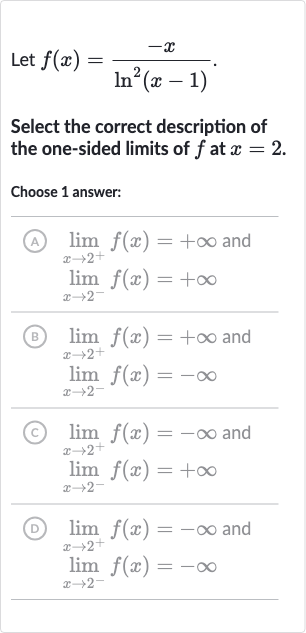Full solution
Q. Let .Select the correct description of the one-sided limits of at .Choose answer:(A) and (B) and (C) and (D) and
- Analyze near : Analyze the function near . We have the function . We need to consider the behavior of the function as approaches from the left () and from the right (). We will look at the numerator and the denominator separately.
- Numerator behavior at : Consider the behavior of the numerator as approaches . The numerator is . As approaches from either side, approaches . There is no ambiguity or complexity in the behavior of the numerator.
- Denominator behavior at : Consider the behavior of the denominator as approaches . The denominator is , which is the square of the natural logarithm of . As approaches , approaches . The natural logarithm of is , so approaches . We need to consider the sign of the natural logarithm as approaches from the left and right to determine the sign of the denominator.
- Denominator sign at : Determine the sign of the denominator as approaches from the left. As approaches from the left (), is slightly less than . The natural logarithm of a number slightly less than is negative, so is negative. Squaring a negative number gives a positive result, so is positive as approaches from the left.
- Denominator sign at : Determine the sign of the denominator as approaches from the right.As approaches from the right (), is slightly more than . The natural logarithm of a number slightly more than is positive, so is positive. Squaring a positive number gives a positive result, so is positive as approaches from the right.
- Combine for one-sided limits: Combine the behavior of the numerator and denominator to find the one-sided limits.Since the numerator approaches and the denominator approaches with a positive sign from both sides, the fraction will approach negative infinity from both sides. This is because a negative number divided by a positive number that is getting closer and closer to zero will result in a number that is getting more and more negative.
More problems from Compare linear, exponential, and quadratic growth
QuestionGet tutor help
QuestionGet tutor help
QuestionGet tutor help
QuestionGet tutor help
QuestionGet tutor help
QuestionGet tutor help
QuestionGet tutor help

